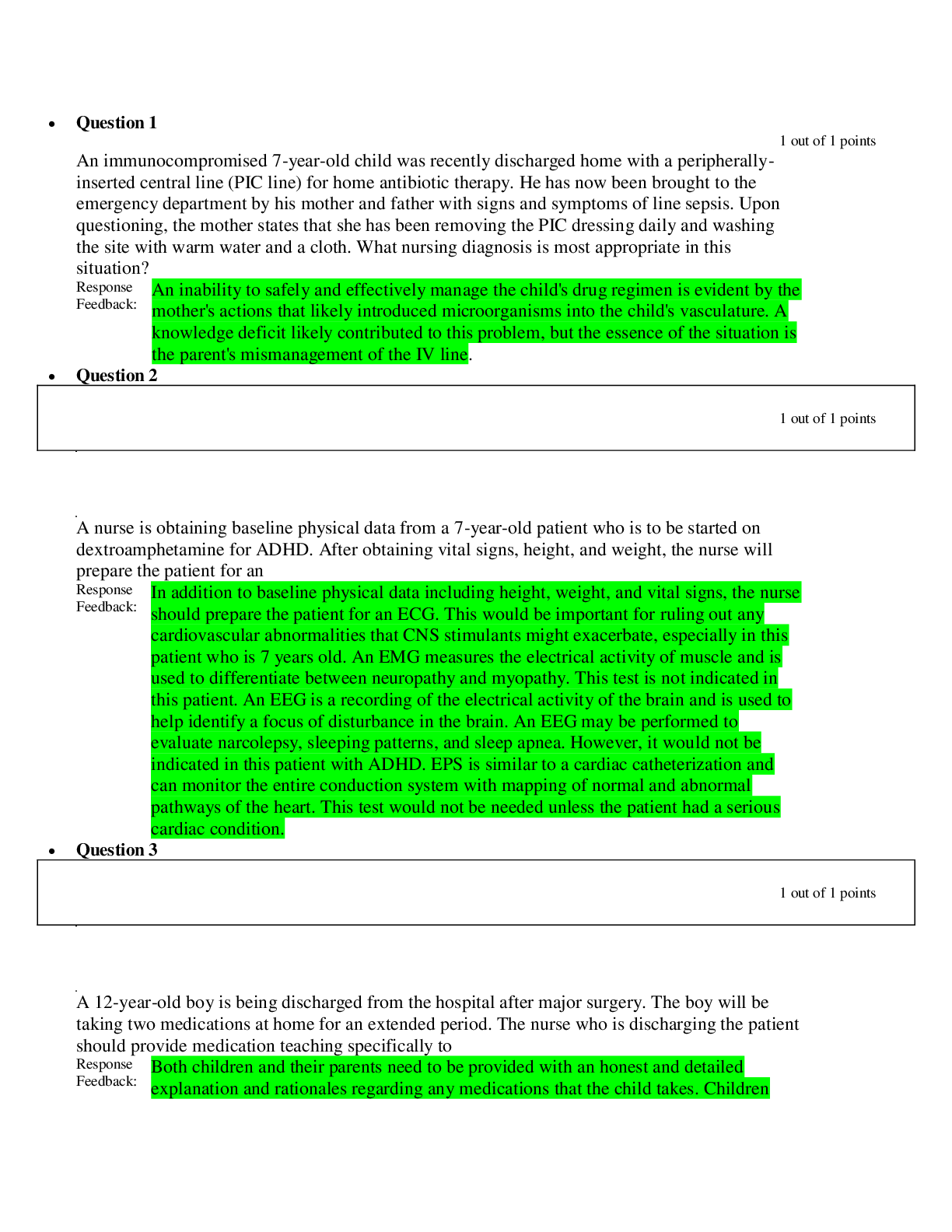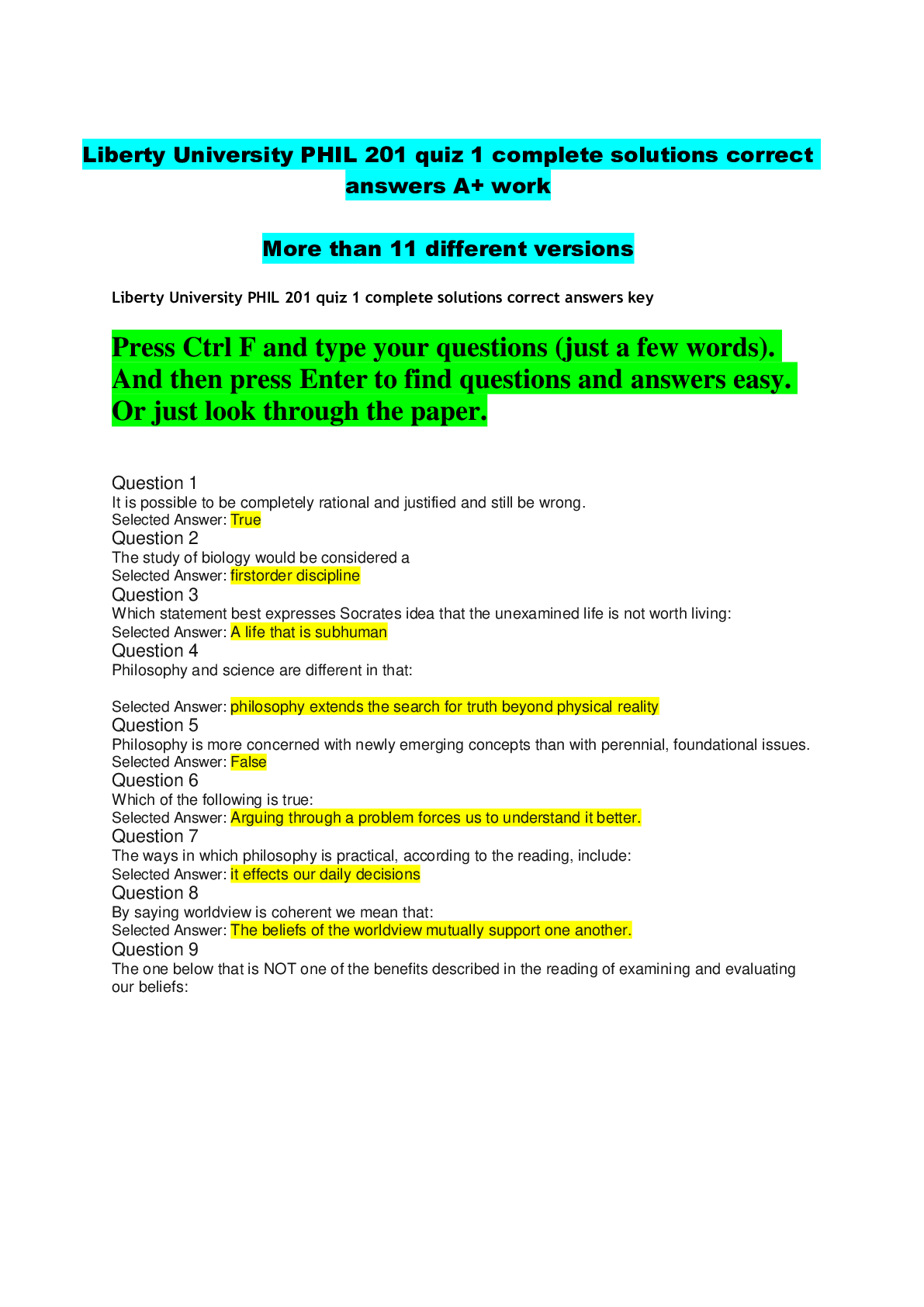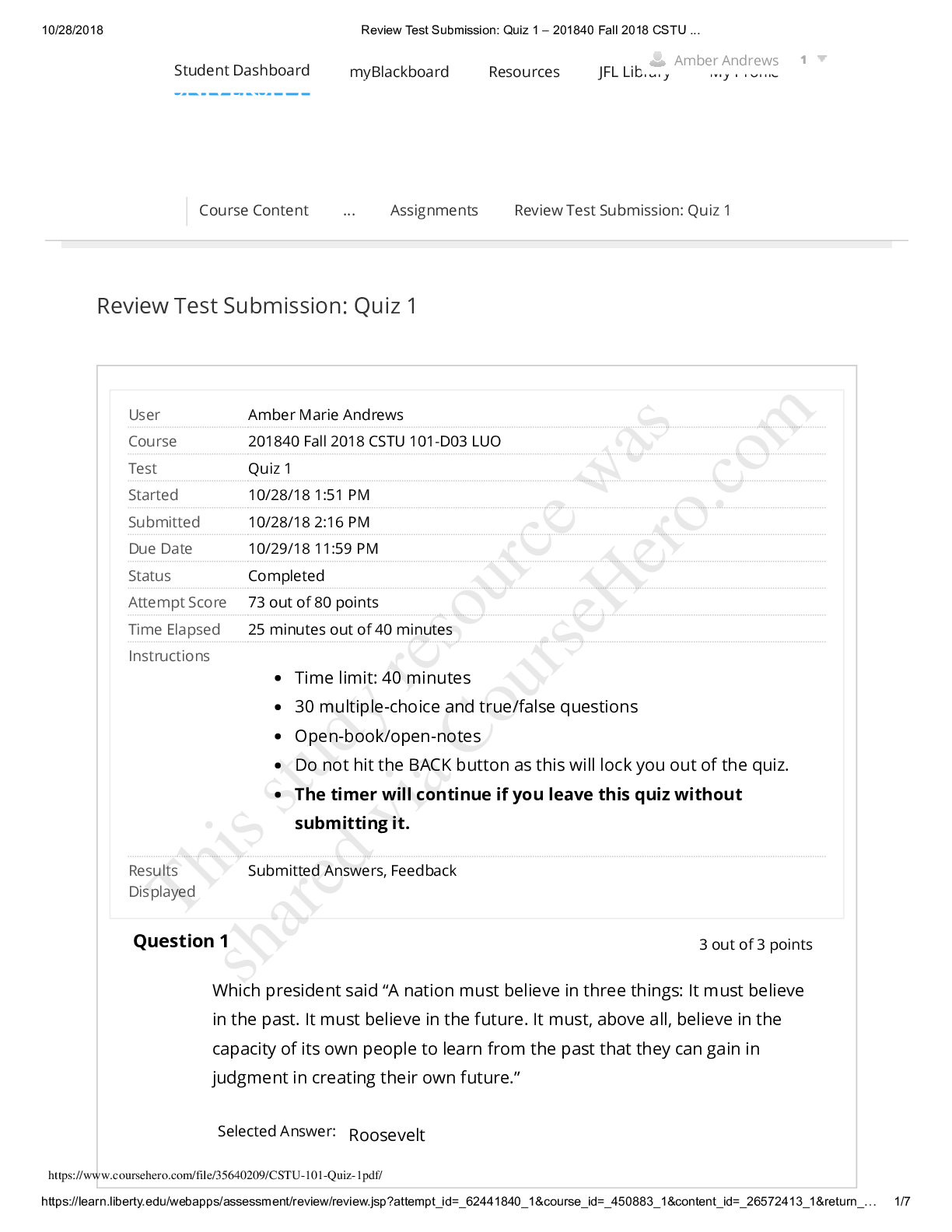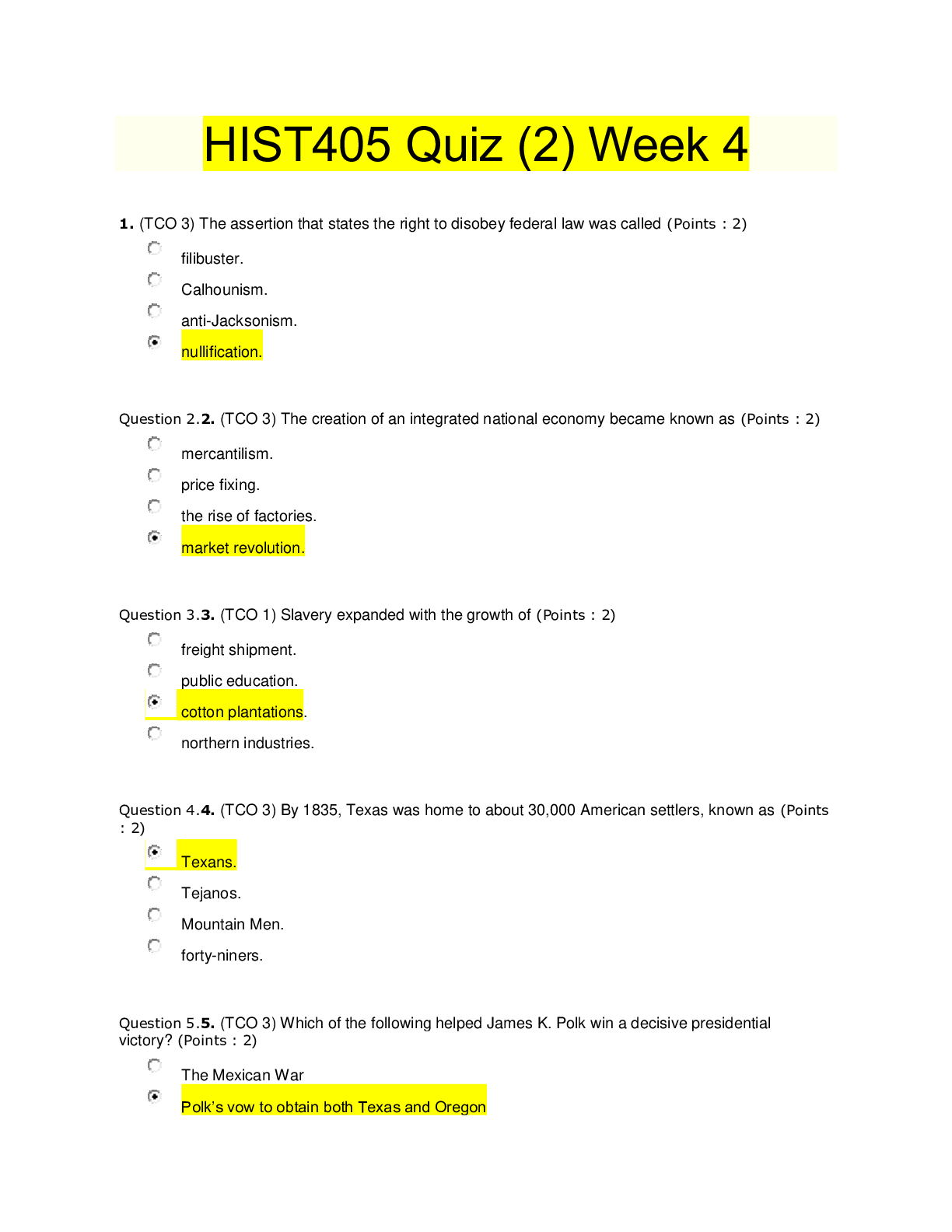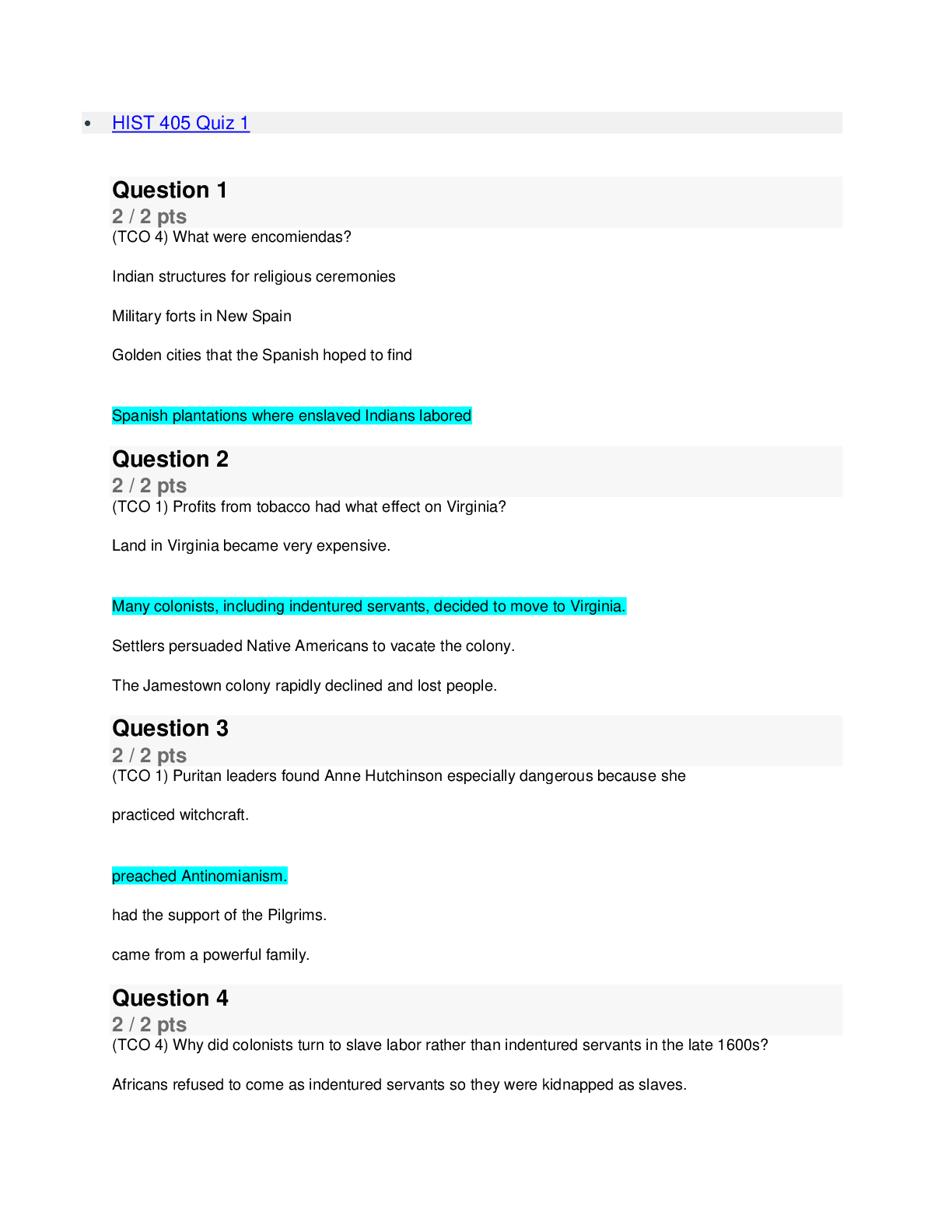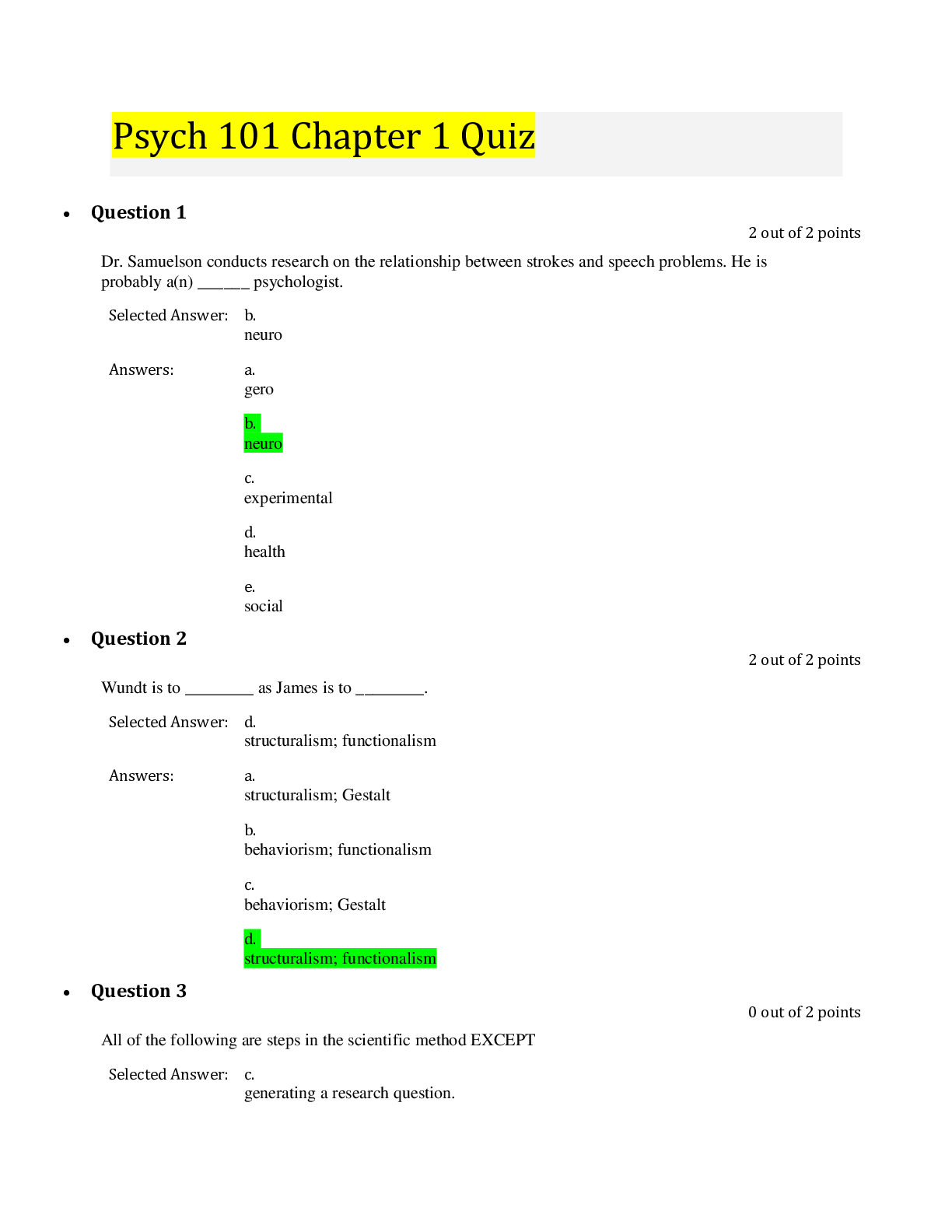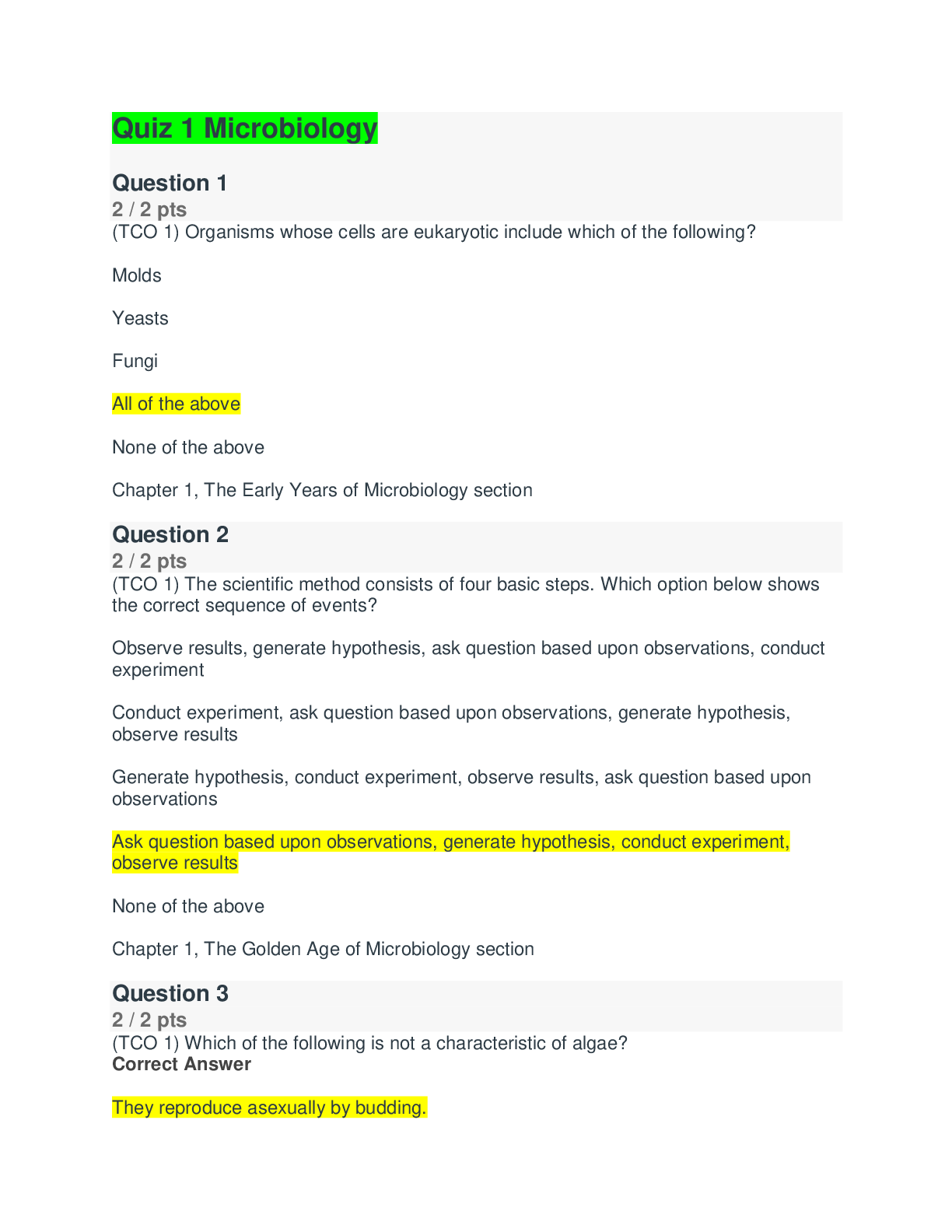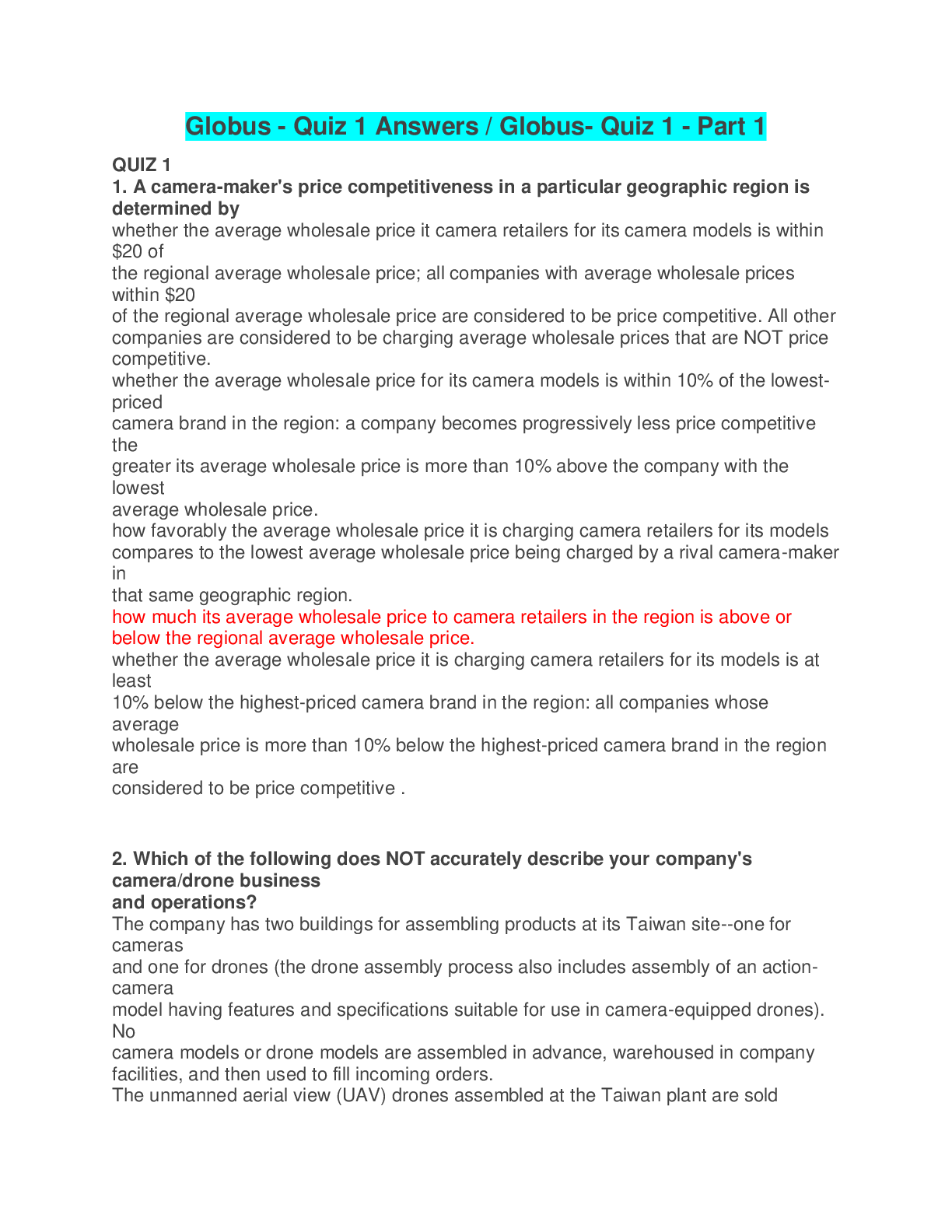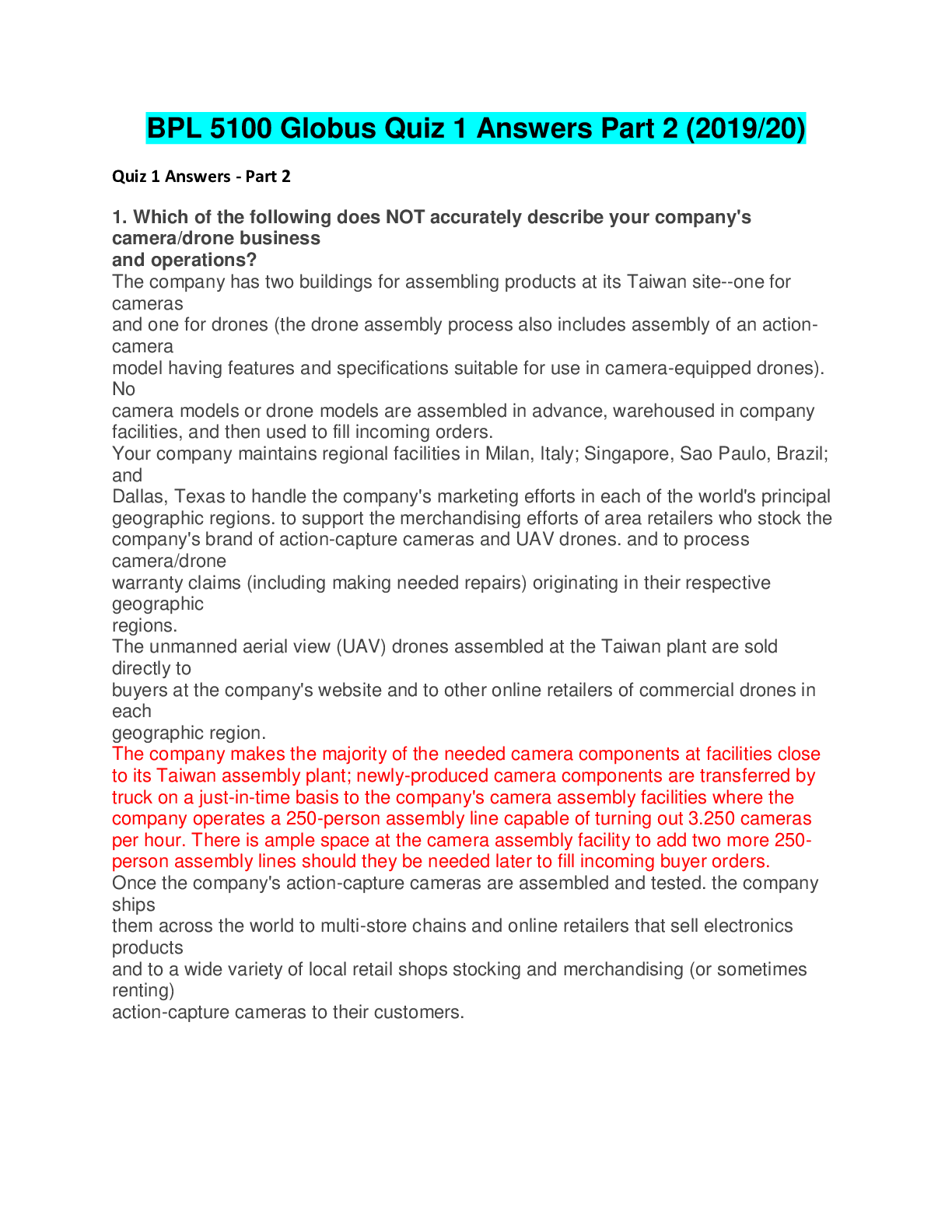Medical Studies > EXAM > NUR 372 Med-Surg Study Guide Quiz 1 _ 2020 – Niagara University | NUR372 Med-Surg Study Guide Quiz (All)
NUR 372 Med-Surg Study Guide Quiz 1 _ 2020 – Niagara University | NUR372 Med-Surg Study Guide Quiz 1 _ 2020
Document Content and Description Below
NUR 372 Med - Surg Study Guide Quiz 1 _ 2020 – Niagara University MED SURG STUDY GUIDE Quiz 1 1. The nurse is caring for a patient who is experiencing anaphylactic shock following the adm... inistration of a medication. Which position is the most appropriate for the nurse to place the patient based on this data? a) Trendelenburg position b) Flat, with legs slightly elevated c) Supine position d) High Fowler position 2. The nurse is conducting an in-service on the spread of infection in the hospital environment. Which statement should the nurse include regarding the most common mode of pathogen transmission? a) “Contact transmission is the most common mode.” b) “Vehicle transmission is the most common mode.” c) “Airborne transmission is the most common mode.” d) “Vector-borne transmission is the most common mode.” 3. The infection prevention and control nurse is providing an in-service regarding multi-drug resistant (MDR) infection. Which is the most common site of MDR MRSA colonization the nurse should include in the presentation? a. Throat b. Axilla c. Perineum d. Anterior Nares 4. Which is the priority nursing action to decrease the risk of spreading infection among patients diagnosed with Multidrug-Resistant Organisms? a. Performing hand hygiene before and after care b. Donning appropriate personal protective equipment (PPE) c. Administering prescribed doses of antibiotics as scheduled d. Monitoring for clinical manifestations of bacterial illnesses 5. A nurse working in an intensive care unit (ICU) is assigned a patient diagnosed with acquired immunodeficiency syndrome (AIDS). Based on this data, which type of precaution does the nurse implement when providing direct care? a. Droplet b. Reverse c. Standard or Universal d. Contact 6. Which questions are appropriate when assessing the effects of the patient’s respiratory diagnosis on activity-exercise patterns? Select all that apply. a. “Are you ever incontinent of urine when you cough?” b. “Do you have trouble walking due to shortness of breath?” c. “Does your spouse wake you in the middle of the night due to snoring?” d. “How many flights of stairs can you walk before you are short of breath?” e. “Do you ever feel full very quickly when eating due to your breathing issues?” 7. The nurse is conducting a health history interview for a patient who is diagnosed with chronic obstructive pulmonary disease (COPD). Which question is appropriate when assessing the patient’s nutrition-metabolic pattern? a. “Have you lost any weight recently?” b. “Do you have trouble getting to the toilet?” c. “Does your breathing wake you up in the night?” d. “Do you have any pain associated with breathing?” 8. The nurse is caring for a patient who is receiving multiple drugs for treatment of tuberculosis. The nurse teaches the patient the rationale for the multiple-drug treatment and evaluates learning as effective when the patient makes which statement? a. “Multiple drugs are necessary to develop immunity to tuberculosis.” b. “Multiple drugs are necessary because I became infected from an immigrant.” c. “Multiple drugs will be required as long as I am contagious.” d. “Multiple drugs are necessary because of the risk of resistance.” 9. The nurse is providing care to a patient receiving chemotherapy for the treatment of laryngeal cancer. Which laboratory test should the nurse anticipate to monitor the patient for neutropenia? a. Platelet count b. Serum potassium c. Red blood cell count d. White blood cell count 10. Which intervention should the nurse implement for a patient who is at risk for aspiration as a result of laryngeal trauma? a. Encouraging voice rest b. Maintaining NPO status c. Placing in high-Fowler’s position d. Providing humidified air via face mask 11. The nurse caring for a patient recovering from an abdominal hysterectomy suspects the patient is experiencing a pulmonary embolism. Which clinical manifestation supports the nurse’s suspicion? a. Nausea b. Decreased urine output c. Dyspnea and shortness of breath d. Activity intolerance 12. A patient is brought into the emergency department (ED) after being in a motor vehicle accident. The patient has suffered traumatic injury that may involve multiple body systems. Which is the priority nursing assessment for this patient? a. Breathing and ventilation b. Circulation with hemorrhage control c. Airway maintenance with cervical spine protection d. Disability and neurological assessment Quiz 2 1. The nurse is reviewing the latest arterial blood gas results for a patient with metabolic alkalosis. Which result indicates that the metabolic alkalosis is compensated? a. pH 7.32 b. HCO3 8 mEq/L c. PaCO2 48 mmHg d. PaCO2 18 mmHg 2. Which diagnostic test should the nurse anticipate when providing care to a patient diagnosed with chronic obstructive pulmonary disease (COPD) to monitor acid-base balance? a. Pulse oximetry b. Bronchoscopy c. Sputum studies d. Arterial blood gases 3. The nurse is reviewing the anatomy of the heart with a patient scheduled for cardiac surgery. Which patient statement indicates additional teaching is required? a. Oxygenated blood returns to the left atrium through the pulmonary vein.” b. “The right atrium receives blood from the superior and inferior vena cava.” c. “Blood leaves the right ventricle and travels through the pulmonary vein to the lungs.” d. “Blood leaves the right ventricle and travels through the pulmonary artery to the lungs.” 4. A patient’s QRS complex is becoming increasingly wider. What is occurring within the heart muscle that is reflected on this tracing? a. The ventricles are repolarizing. b. Atrial repolarization is occurring. c. Ventricular depolarization is prolonged. d. The atria depolarize and the impulse at the AV node is delayed. 5. A patient with shortness of breath has a heart rhythm of 46 beats per minute. Which medication should the nurse anticipate being prescribed for this patient? a. Atropine sulfate b. Atenolol (Tenormin) c. Diltiazem (Cardizem) d. Adenosine (Adenocard) 6. A patient is in normal sinus rhythm with prolonged PR intervals. What treatment should the nurse expect to be prescribed for this patient? a. Continue to monitor b. Anticipate defibrillating c. Prepare for cardioversion d. Prepare for pacemaker insertion 7. A patient is admitted for treatment of pericarditis. For which additional health problem should the nurse expect the patient to be evaluated? a. Asthma b. Myocardial infarction c. Infective endocarditis d. Chronic obstructive pulmonary disease 8. During an assessment a patient describes experiencing chest pain with exercise that disappears with rest. For which health problem should the nurse plan care for this client? a. Stable angina b. Variant angina c. Unstable angina d. Prinzmetal’s angina 9. A patient is diagnosed with an abdominal aneurysm measuring 5 cm. Which teaching material should the nurse prepare for this patient? a. Dietary changes b. Preoperative and postoperative care c. Actions to reduce high blood pressure d. Activities to prevent aneurysm rupture 10. A patient is being evaluated for chest pain in the emergency department. Which laboratory test is the best to determine if this patient has experienced an acute myocardial infarction? a. Troponin b. Prothrombin time c. Creatine kinase-MB d. Complete blood count 11. The nurse is caring for a patient experiencing cardiogenic shock. Which medication should the nurse expect to be prescribed to improve this patient’s cardiac output? a. Nitroglycerin b. Morphine sulfate c. Norepinephrine (Levophed) d. Dobutamine hydrochloride (Dobutamine) 12. A patient has a heart rate of 132 beats per minute. What should the nurse assess to help determine the reason for this rate? Select all that apply. a. Muscle tone b. Temperature c. Urine output d. Bowel sounds e. Blood pressure 13. The nurse is providing care to a patient who is admitted after a morphine overdose. Which acid-base imbalance should the nurse plan this patient’s care to reflect? a. Metabolic acidosis b. Metabolic alkalosis c. Respiratory acidosis d. Respiratory alkalosis 14. A patient is recovering from a cardiac catheterization. For which finding should the nurse notify the health-care provider? a. Warm right foot b. Discomfort lying flat for six hours c. Urine output 250 mL/2 hours d. Hematoma formation at puncture site 15. When analyzing a patient’s electrocardiogram, the nurse notes that the P wave is normal. What criteria did the nurse use to make this decision? a. Pointed and skinny in width b. Small and rounded in lead II c. Upright and rounded in lead II d. Length 0.10 seconds and height 2.5 mm 16. A patient with infective endocarditis is being started on intravenous antibiotics. What should the nurse include when teaching about this medication? a. “The medication may be changed every few days.” b. “The typical course of this medication is 7 to 10 days.” c. “Expect to continue this medication for four to six weeks at home.” d. “Since this infection is resilient, you might be taking antibiotics for life.” 17. An older patient seeks emergency care for a sudden onset of severe abdominal pain. Which health problem should the nurse suspect be occurring in this patient? a. Rupture of the appendix b. Small bowel obstruction c. Passing of a kidney stone d. Rupture of an abdominal aneurysm 18. The nurse is caring for a patient experiencing an acute myocardial infarction. Which assessment finding indicates a decrease in this patient’s cardiac output? a. Chest pain b. Restlessness c. Low urine output d. ST segment elevation Quiz 3 1. The nurse is concerned that a patient is at high risk for having a stroke. What finding did the nurse use to make this clinical decision? a. BMI 24.8 b. Heart rate 90 bpm c. Blood pressure 182/90 mm Hg d. Pulse oximetry 98% on room air 2. The nurse is preparing materials for the families of patients who have sustained a stroke. What information should the nurse include to reduce the risk for additional strokes? a. Heart-healthy diet b. Smoking cessation c. Stress management d. Weight-reduction strategies 3. A patient seeks treatment for progressively deteriorating motor and sensory function. What question is essential for the nurse to ask when completing this patient’s health history? a. “Have you been around any small children?” b. “When was the last time you had anything to eat?” c. “When was the last time you traveled out of the country?” d. “Have you recently experienced any lung or stomach infections?” (Guillian Barre Syndrome) 4. The nurse notes that a patient has been diagnosed with trigeminal neuralgia. What should the nurse expect the patient to be experiencing? a. Pain b. Nausea c. Sensory deficit d. Motor weakness 5. A patient has a new onset of back pain radiating down the left leg. For which health problem should the nurse expect this patient to be evaluated? a. Meningitis b. Spinal cord tumor c. Multiple sclerosis d. Amyotrophic lateral sclerosis 6. The nurse is preparing material for a community health fair. What should the nurse identify as being the most common cause of headache pain in adults? a. Mixed b. Cluster c. Tension d. Migraine 7. The health-care professional is identifying the best course of treatment for a patient with a brain tumor. What should be considered when selecting chemotherapeutic agents for this patient? a. Cause mild neutropenia b. Cross the blood-brain barrier c. Restrict weight loss and hair loss d. Limit the development of mucositis 8. The nurse is admitting a patient experiencing photophobia and nuchal rigidity. For which diagnostic test should the nurse prepare this patient? a. Lumbar puncture b. Evoked potentials c. CT scan with contrast d. Electroencephalogram 9. The nurse suspects that a patient is experiencing Parkinson’s disease. What did the nurse assess to make this clinical determination? a. Photophobia b. Nuchal rigidity c. Slow movements d. Elevated body temperature 10. During a home visit the nurse is concerned that the patient with Alzheimer’s disease is deteriorating. What patient observation caused the nurse to have this concern? a. Sitting in a chair watching a television program b. Staying away from the door leading to the back yard c. No recognition of bowel incontinence during the visit d. Eating cheese and crackers placed on a table near the living room chair 11. The nurse is preparing to assess an older patient’s neurologic status. What should the nurse keep in mind during this assessment? a. Reaction time is slower b. Flexibility is maintained c. Pain sensation is heightened d. Body movements are quicker 12. The nurse notes that an older patient sways when moving from a sitting to a standing position. What is this patient at risk for experiencing? a. Falls b. Hypothermia c. Altered pain sensation d. Reduced oxygen to the brain Quiz 5 1. Which intervention would be a priority when providing care to a patient recovering from thoracic injuries sustained from a motor vehicle crash? a) Monitor urine output b) Assess vital signs c) Perform passive range of motion to all extremities d) Assist to deep breathe and cough every two hours 2. The nurse identifies the nursing diagnosis of Ineffective Peripheral Tissue Perfusion as being appropriate for a patient with septicemia. Which intervention will address this patient’s health problem? a) Monitor for cyanosis. b) Monitor heart rate every hour. c) Assess temperature every four hours. d) Monitor pupil reactions every eight hours. 3. The nurse provides care to a patient who is admitted for a myocardial infarction (MI). When planning care for this patient, the nurse includes interventions that address which type of shock? a) Obstructive b) Distributive c) Cardiogenic d) Hypovolemic 4. A nurse is caring for a patient who was involved in a motor vehicle accident who has lost approximately 1,500 mL of blood. Based on this data, which type of shock is the patient experiencing? a) Hypovolemic b) Cardiogenic c) Distributive d) Obstructive 5. Which organization in the United States mandates ongoing disaster preparedness for hospitals? a) The Joint Commission (TJC) b) The local government c) The state government d) The Occupational Safety and Health Administration (OSHA) 6. A patient is prescribed epinephrine for the prevention of anaphylactic shock. The patient states, “I thought shock was about heart failure.” Which response by the nurse is most appropriate? a) “There are many kinds of shock that also include infection, nervous system damage, and loss of blood.” b) “Heart failure is the most serious kind of shock; others include infection, kidney failure, and loss of blood.” c) “There are many kinds of shock: heart failure, nervous system damage, loss of blood, and respiratory failure.” d) “Allergic response is the most fatal type of shock; other types involve loss of blood, heart failure, and liver failure.” 7. Which is the essential nursing skill for the triage process in the emergency department? a) Evaluating care b) Setting priorities c) Formulating diagnoses d) Implementing interventions 8. Which is the priority in the preparedness of health-care professionals in any type of disaster plan? a) Identification of hazards b) Cooperation with state authorities c) Collaboration with local authorities d) Implementation of federal mandates 9. Which observation indicates that interventions provided to a patient with neck injuries from a motor vehicle crash have been successful? a) Urine is clear and odorless from indwelling catheter b) Moves all four extremities independently, feeds self, and participates in partial bath c) Unable to move independently in bed d) Rests in bed with lights and television turned off 10. The nurse works in an emergency department (ED) in a city that experiences an earthquake. Which patient injury does the nurse prepare to treat based on this information? a) Drowning b) Electrocution c) Crush injuries d) Open brain injuries 11. Which type of event can often be handled by an individual hospital disaster plan without collaboration with other systems? a) A motor vehicle accident involving five cars b) A tornado destroying 50 homes and businesses c) An act of terrorism injuring and kills hundreds of people d) A hurricane causing flooding, displacing thousands of people 12. The nurse is helping devise a training plan to familiarize health-care providers with emergency response procedures. Which training measure is most effective to adequately prepare the trainees? a) Drills b) Tabletop exercises c) Access to the policy d) Computer simulations Mid Term 1. The nurse is caring for a patient who is experiencing anaphylactic shock following the administration of a medication. Which position is the most appropriate for the nurse to place the patient based on this data? a) Trendelenburg position b) Flat, with legs slightly elevated c) Supine position d) High Fowler position 2. Which is the priority nursing action to decrease the risk of a transfusion reaction? a) Assessing the patient’s vital signs per policy b) Documenting the procedure in the medical record c) Verifying the patient’s identity using two identifiers d) Checking the bag to ensure it is the correct blood type 3. The nurse is planning care for several patients in the hospital environment. Which is a risk factor for a patient developing Clostridium difficile? a) Recent use of antibiotics b) Recent surgical procedure Acinobacter c) Current intensive care unit stay MRSA d) Prolonged rehabilitation unit VRE 4. Which is the priority nursing action to decrease the risk of spreading infection among patients diagnosed with Multidrug-Resistant Organisms? a) Performing hand hygiene before and after care b) Donning appropriate personal protective equipment (PPE) c) Administering prescribed doses of antibiotics as scheduled d) Monitoring for clinical manifestations of bacterial illnesses 5. Which antibiotic prescription should the nurse anticipate when providing care to a patient who is diagnosed with multi-drug resistant (MDR) MRSA? a) Vancomycin b) Metronidazole c) Ampicillin-sulbactam d) Quinupristin-dalfopristin 6. The nurse is conducting an in-service on the spread of infection in the hospital environment. Which statement should the nurse include regarding the most common mode of pathogen transmission? a) “Contact transmission is the most common mode.” b) “Vehicle transmission is the most common mode.” c) “Airborne transmission is the most common mode.” d) “Vector-borne transmission is the most common mode.” 7. A nurse is performing an admission assessment on a patient with symptoms that indicate human immunodeficiency virus (HIV). Which question from the nurse addresses a major risk factor for contracting HIV? a) “Has your partner been experiencing these symptoms?” b) “When was your first sexual experience?” c) “Have you had any fever, diarrhea, or chills over the last 48 hours?” d) “Have you ever experimented with intravenous drugs?” 8. A nurse working in an intensive care unit (ICU) is assigned a patient diagnosed with acquired immunodeficiency syndrome (AIDS). Based on this data, which type of precaution does the nurse implement when providing direct care? a) Droplet b) Reverse c) Standard d) Contact 9. Which is the priority action for a nurse who is exposed to a needle-stick injury while providing patient care? a) Washing the injury under running water b) Squeezing the site to remove the patient’s blood c) Taking two or three drugs for 28 days d) Consenting to a human immunodeficiency virus (HIV) test 10. The nurse is providing care to a patient who is diagnosed with asthma. Which noninvasive method will the nurse use to assess the patient’s oxygenation status? a) Pulse oximetry b) Arterial blood gas c) Venous blood gas d) Cardiopulmonary monitor 11. The nurse is conducting a respiratory assessment. Which respiratory manifestation indicates inadequate oxygenation? a) Mild hypertension b) Cool, clammy skin c) Dyspnea on exertion d) Unexplained apprehension 12. A patient with the flu is experiencing tachypnea. What intervention is inappropriate to address in the nursing diagnosis of Ineffective Breathing Pattern related to the flu? a) Maintain adequate hydration b) Keep the head of the bed elevated c) Teach the patient coughing, deep breathing, and hydration d) Prepare the patient for the possibility of a tracheostomy tube. 13. The nurse is planning care for a patient diagnosed with influenza. Which intervention should the nurse include when planning this patient’s care? a) Placing a ventilator in the room b) Notifying other departments of the diagnosis c) Placing the patient in a negative air flow room d) Placing droplet and contact precaution signs on the patient room door 14. The nurse provides care for an adult patient who is diagnosed with pneumonia. Which clinical manifestation does the nurse anticipate upon patient assessment? a) Bradypnea b) Tachycardia c) Strong peripheral pulses d) Bilateral breath sounds clear 15. The nurse is providing education to a patient who is receiving chemotherapy in the treatment of laryngeal cancer. Which medication should the nurse include to decrease the risk for nausea and vomiting? a) Antiemetic b) Decongestant c) Antihistamine d) Corticosteroid 16. The nurse is providing care to a patient receiving chemotherapy for the treatment of laryngeal cancer. Which laboratory test should the nurse anticipate to monitor the patient for neutropenia? a) Platelet count b) Serum potassium c) Red blood cell count d) White blood cell count 17. The nurse is providing care to a patient newly diagnosed with asthma. When developing the patient’s plan of care, which intervention would be most appropriate to promote airway clearance? a) Provide adequate rest periods b) Reduce excessive stimuli c) Assist with activities of daily living d) Place in Fowler position 18. The nurse is planning care for the patient diagnosed with chronic obstructive pulmonary disease (COPD) who has a breathing rate of 32 per minute, elevated blood pressure, and fatigue. Which nursing diagnosis is the priority for this patient? a) Ineffective Coping b) Ineffective Airway Clearance c) Anxiety d) Ineffective Breathing Pattern 19. The nurse provides care in the emergency department (ED) for a patient admitted for an asthma exacerbation. Which clinical manifestation indicates a need for a priority intervention? a) Dyspnea b) Wheezes c) Increased blood pressure d) Diminished breath sounds 20. A patient with a respiratory rate of eight breaths per minute has an oxygen saturation of 82%. Which nursing diagnosis is a priority for this patient? a) Risk for Infection b) Impaired Spontaneous Ventilation c) Risk for Acute Confusion d) Decreased Cardiac Output 21. A patient scheduled for surgery is being instructed in leg exercises and the pneumatic compression device. The nurse includes these instructions to decrease which postoperative complication? a) Infection b) Delayed wound healing c) Contractures d) Deep vein thrombosis 22. The nurse is preparing to discharge a patient recovering from a pulmonary embolism. Which topics are appropriate for the nurse to include in the teaching session? a) Resume the use of any over-the-counter medications b) Diet to include green leafy vegetables c) Anticoagulant administration schedule d) Resume normal activity level 23. The nurse is caring for a patient admitted with renal failure and metabolic acidosis. Which clinical manifestation would indicate to the nurse that planned interventions to relieve the metabolic acidosis have been effective? a) Tachypnea b) Palpitations c) Increased deep tendon reflexes d) Decreased depth of respirations 24. The nurse is providing care to a patient who has been vomiting for several days. The nurse knows that the patient is at risk for metabolic alkalosis because gastric secretions have which characteristic? a) Gastric secretions are acidic b) Gastric secretions are alkaline c) Gastric secretions have a foul smell d) Gastric secretions are green in color 25. A patient is admitted to the emergency department for the treatment of a drug overdose causing acute respiratory acidosis. Which substance noted on the toxicology report is the most likely cause for the current diagnosis? a) PCP b) Cocaine c) Marijuana d) Oxycodone 26. The nurse is providing care to a patient who is admitted to the hospital with sudden, severe abdominal pain. Which arterial blood gas supports the patient’s current diagnosis of respiratory alkalosis? a) pH is 7.35 and PaO2 is 88. b) pH is 7.30 and HCO3 is 30.3 c) pH is 7.47 and PaCO2 is 25. d) pH is 7.33 and PaCO2 is 36 27. The nurse is preparing to auscultate the heart sounds of a patient with mitral valve regurgitation. Which sound should the nurse expect to hear? a) Rub b) Click c) Murmur d) Atrial gallop 28. A patient is scheduled for a transesophageal echocardiogram (TEE). What information should the nurse expect to be provided from this test? a) Cardiac filling pressures b) Heart function during stress c) Integrity of cardiac arteries d) Presence of clots in the atria 29. The nurse is observed marching out the rhythm on a patient’s cardiac monitor tracing. What is this nurse assessing? a) Rate b) Polarity c) Regularity d) Amplitude 30. A patient with shortness of breath has a heart rhythm of 46 beats per minute. Which medication should the nurse anticipate being prescribed for this patient? a) Atropine sulfate b) Atenolol (Tenormin) c) Diltiazem (Cardizem) d) Adenosine (Adenocard) 31. A patient with atrial fibrillation has a heart rate of 90 beats per minute. Which manifestation should the nurse expect to assess in this patient? a) Headache b) Chest pain c) Palpitations d) Hypotension 32. A patient is experiencing supraventricular tachycardia. What should be done before determining this patient’s treatment? a) Assess for thyroid disease b) Identify the underlying rhythm c) Evaluate serum electrolyte values d) Study lifestyle and behavioral habits 33. The nurse is preparing to defibrillate a patient using a monophasic defibrillator. Which setting should the nurse use for this treatment? a) 50 J b) 100 J c) 150 J d) 200 J 34. A patient is being cardioverted for symptomatic atrial fibrillation. At which point of the cardiac cycle will the electric impulse occur? a) At the end of the P wave b) Before the QRS complex c) At the peak of the R wave d) After the QRS complex but before the T wave 35. The nurse provides care to a patient who is being cardioverted. Which is the priority nursing action before initiating the shock? a) Documenting the vital signs b) Telling the patient what to expect c) Asking the provider, “Are you clear?” d) Stating, “I am clear, you are clear, we are all clear.” 36. The nurse applies oxygen two liters via nasal cannula on a patient with coronary artery disease. What should the nurse explain as being the purpose of the oxygen? a) Ensures vessel dilation b) Ensures perfusion to cerebral tissues c) Supports myocardial oxygen demand d) Facilitates the metabolism of medications 37. The nurse is evaluating teaching provided to a patient with coronary artery disease. Which patient statement indicates that additional teaching is required? a) “I will adhere to my smoking cessation plan.” b) “I am to reduce my daily intake of saturated fat.” c) “I can take up to three doses of nitroglycerin 15 minutes apart.” d) “I am to follow the exercise plan for 30 minutes, five days a week.” 38. Which statement from a patient scheduled for a cardiac catheterization indicates the need for further education? a) “I won’t have any activity restrictions after the procedure is complete.” b) “I will have blood drawn to check my kidney function before the procedure.” c) “I will drink plenty of water after the procedure to flush the dye from my system.” d) “I won’t eat or drink anything by mouth after midnight the day of the procedure.” 39. The nurse monitors for which clinical manifestations in a patient diagnosed with right-sided heart failure (HF)? a) Fatigue b) Shortness of breath c) Crackles with auscultation d) Edema in the lower extremities 40. A patient’s blood pressure is 158/90 mm Hg; however, previous measurements have been within normal limits. Which intervention would be appropriate for this patient? a) Investigate for additional health problems b) Prepare teaching on antihypertensive medications c) Schedule an additional measurement in a few weeks d) Instruct on the effects of hypertension on major body organs 41. A patient is being evaluated for medication therapy to treat atherosclerosis. For which health problem would a statin be contraindicated? a) Diverticulitis b) Celiac disease c) Liver cirrhosis d) Type 2 diabetes mellitus 42. A patient is diagnosed with an abdominal aneurysm measuring 5 cm. Which teaching material should the nurse prepare for this patient? a) Dietary changes b) Preoperative and postoperative care c) Actions to reduce high blood pressure d) Activities to prevent aneurysm rupture 43. The nurse is preparing medications for a patient experiencing an acute myocardial infarction. Which medication will dilate the patient’s coronary blood vessels? a) Heparin b) Fibrinolytics c) Nitroglycerin d) Beta blockers 44. The nurse provides discharge instructions to a patient who is admitted for a myocardial infarction. Which patient statement indicates a need for additional teaching? a) “I will take the Lipitor to reduce my cholesterol levels.” b) “I will take the Lopressor to decrease my heart’s demand for oxygen.” c) “I will take the Plavix to prevent the platelets from forming new clots.” d) “I will take the sublingual nitroglycerin each day to prevent chest pain.” 45. The nurse is reviewing the complete blood cell (CBC) count for a patient recently admitted to the medical-surgical unit. The CBC count is as follows: platelet 180,000/mm; hemoglobin 15 g/dL; red blood cells – 4.4 x 10^12 cells/L; white blood cells – 6,000/mm3 . Which conclusion by the nurse is appropriate? a) The patient is anemic. b) The patient has leukopenia. c) The patient has thrombocytopenia. d) The patient’s laboratory values are within normal limits. 46. Which food should the nurse recommended for a patient who is diagnosed with iron deficiency anemia? a) Shellfish b) Lima beans c) Citrus fruits d) Milk products 47. Which drug prescription should the nurse anticipate to prevent the formation of clots for a patient diagnosed with deep vein thrombosis (DVT)? a) Warfarin b) Vitamin K c) Abciximab d) Streptokinase 48. The home healthcare nurse is preparing a care plan for a patient with severe anemia. The patient currently lives alone and states, “I can’t even walk to the kitchen without getting winded.” What would be the priority nursing diagnosis for this patient? a) Hopelessness b) Activity Intolerance c) Altered Nutrition, Less than Body Requirements d) Anxiety 49. A patient complaining of mouth soreness had gastric bypass surgery one year ago. During the assessment, the nurse notes the patient’s tongue is beefy, red, and smooth and the patient’s skin appears yellowish. Which additional information is most likely needed before diagnosing this patient? a) Vitamin B6 levels b) Vitamin B12 levels c) Potassium levels d) Iron levels 50. The nurse prepares to administer the prescribed intramuscular injection (IM) iron to a patient. Which is the priority action for this task? a) Using the Z-track method b) Assessing for tachycardia c) Applying pressure to the injection site d) Monitoring the patient for cardiotoxic effects Quiz 4 1. The nurse is caring for an adolescent Asian patient with a strong family history of breast cancer. What should the nurse teach the patient regarding cancer prevention? a. Perform monthly breast self-examination. b. Teach the side effects of cancer treatment. c. Talk to family members who have the disease. d. Discuss cancer fears with the health-care provider. 2. A patient with anemia caused by chemotherapy is prescribed synthetic erythropoietin. When teaching the patient about the therapeutic effect of this treatment, which is appropriate for the nurse to include? a. Increase in platelets b. Decrease in lymph fluid c. Increase in red blood cells d. Decrease in white blood cells 3. During an assessment, the nurse notes that a patient receiving radiation treatments for breast cancer has excoriated skin. What is the priority nursing diagnosis? a. Risk for Infection b. Activity Intolerance c. Excess Fluid Volume d. Ineffective Breathing Pattern 4. A patient being treated with chemotherapy for cancer complains of fatigue, pallor, progressive weakness, exertional dyspnea, headache, and tachycardia. Which diagnosis should the nurse use as the priority when planning this patient’s care? a. Powerlessness b. Ineffective Coping c. Activity Intolerance d. Imbalanced Nutrition, Less than Body Requirements 5. The nurse is caring for a patient with leukemia who is experiencing neutropenia as a result of chemotherapy. Which action should the nurse include in the plan of care for this patient? a. Restrict fluid intake b. Replace hand hygiene with gloves c. Restrict visitors with communicable illnesses. d. Insert an indwelling urinary catheter to prevent skin breakdown 6. The nurse provides care to a patient who is newly diagnosed with bladder cancer. Which assessment data collected by the nurse supports this diagnosis? a. Anorexia b. Dysphagia c. Hematuria d. Somnolence 7. The nurse provides education to a patient who is diagnosed with breast cancer and asks about sites of metastases. Which is the best response by the nurse? a. “You should not worry about this now.” b. “Your type of cancer may spread to the skin.” c. “Your type of cancer may spread to the bones.” d. “I will have the provider discuss this information with you.” 8. The nurse provides care to a patient who presents to the emergency department (ED) with vomiting and abdominal distention. The patient is being treated for cancer with chemotherapy. Which assessment question does the nurse ask based on the current data? a. “Are you experiencing blurred vision?” b. “When was your last bowel movement?” c. “Have you been urinating more frequently?” d. “Do you have any bruises that cannot be explained? 9. The nurse is assessing the patient for palliative care. When assessing the psychosocial and psychiatric domain, which should the nurse include? a. Financial concerns b. Pain c. Depression d. Spiritual concerns 10. A competent older adult patient has a living will that expresses the patient’s desire to avoid resuscitation and heroic life support measures. The patient’s family, however, is not supportive of this directive and plans to contest the living will. Which nursing action is appropriate based on the current situation? a. Notify the hospital attorney. b. Contact the Social Services department. c. Place the document on the patient’s medical record. d. Explain to the patient that the conflict could invalidate the document. 11. The nurse is providing care for a Catholic patient who has suffered a massive cerebral hemorrhage and is not expected to survive. Which intervention by the nurse is most appropriate? a. Contact a priest to deliver the Sacrament of the Sick. b. Make plans for the family to wash the body after death. c. Contact a rabbi so that the patient can participate in prayer. d. Discuss the need to cremate the patient, as burial is not accepted in this faith. 12. Which concept exemplifies a well-managed death experience for a terminal patient and family members? a. Allowing the patient to die alone b. Withholding pain medication to decrease addiction c. Encouraging a lengthy dying process to allow for goodbyes d. Preparing the patient and the family for the process of dying Quiz 5 [Show More]
Last updated: 1 year ago
Preview 1 out of 38 pages
Instant download

Buy this document to get the full access instantly
Instant Download Access after purchase
Add to cartInstant download
Reviews( 0 )
Document information
Connected school, study & course
About the document
Uploaded On
Sep 21, 2020
Number of pages
38
Written in
Additional information
This document has been written for:
Uploaded
Sep 21, 2020
Downloads
0
Views
44














